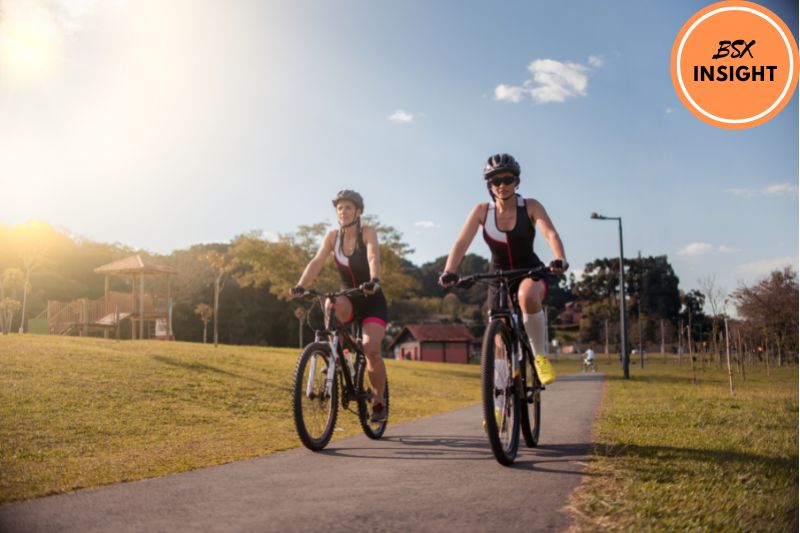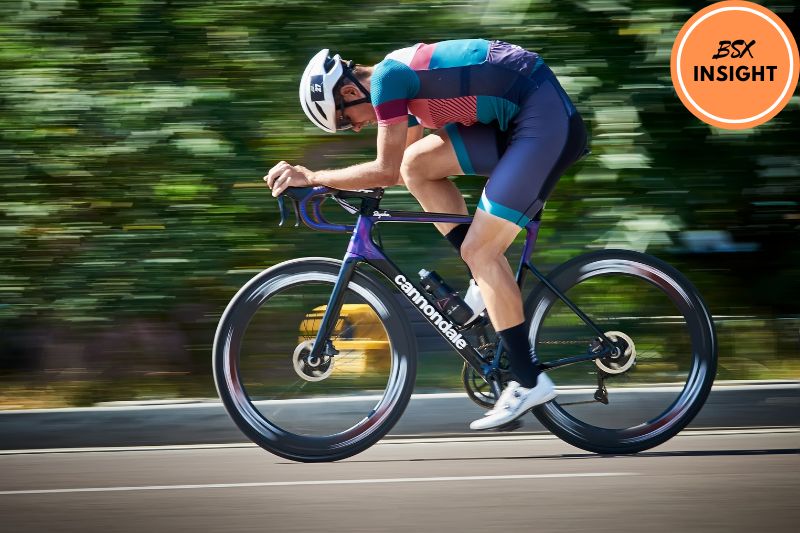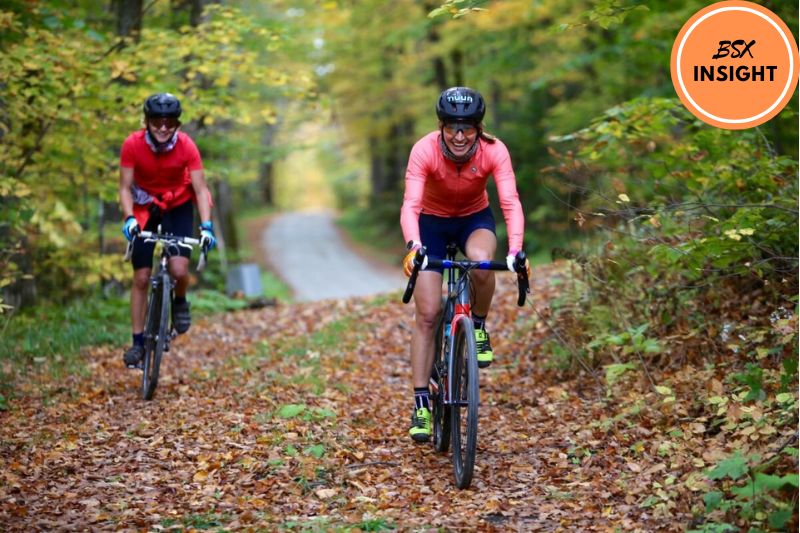Training for a 100-mile bike ride is daunting, but with the right mindset, preparation, and training, it can be a challenging and rewarding experience.
Whether you’re a seasoned cyclist or a beginner, training for a century ride requires dedication and hard work. From building up your endurance to fine-tuning your nutrition, many factors must be considered when preparing for such a long-distance ride.
In this article, BSXInsight will explore some tips and tricks for how to train for 100 mile bike ride, so you can feel confident and prepared as you embark on this incredible journey.
How To Train For 100 Mile Bike Ride? Train For Planning

Before embarking on any training program, it’s essential to have a plan. Consider the amount of time you have until the event and your current fitness level.
It’s best to start training at least three months before the ride.
If you’re a beginner, start with shorter distances and gradually work your way up to longer rides. Once you have a plan, stick to it, but be flexible and adjust as needed.
Long Ride: The Meat
The long ride is the backbone of any training plan for a 100-mile bike ride. It’s essential to build up your endurance and get used to spending hours in the saddle.
Start with a long ride of 30-40 miles and gradually increase the distance by 10% each week.
Aiming to reach 80-90 miles before the event gives you the confidence and mental preparation needed to tackle the full distance.
During the long ride, pace yourself and focus on completing the distance rather than speed. Bring enough water, energy gels, and snacks to keep yourself fueled throughout the ride. It’s also essential to listen to your body and take breaks when needed.
Steady Ride: The Bread and Butter
The steady ride is the bread and butter of your training plan. These rides are typically shorter than long rides but are done at a sustainable pace.
It’s essential to focus on building your aerobic fitness, which will help you tackle the distance with ease. Aim to do at least two steady rides per week, gradually increasing the duration and intensity.
During the steady ride, focus on maintaining a steady pace and pedaling efficiency.
Experiment with different riding positions to find what works best for you. It’s also a good idea to incorporate hills into your steady rides to build strength and endurance.
Speed Ride: The Secret Sauce
The speed ride is the secret sauce of your training plan. These rides are shorter and more intense, focusing on building power and speed.
They will also help you get used to riding at a faster pace, which will come in handy during the event. Aim to do one-speed ride per week, focusing on intervals, sprints, and hill repeats.
During the speed ride, push yourself to ride at a higher intensity than your steady rides. It’s important to warm up properly before starting the speed ride to prevent injury. Don’t forget also to include rest days in your training plan to allow your body to recover.
6 Tips for Riding a Century Successfully

Riding a century or a 100-mile bike ride is an exciting and challenging experience for cyclists of all levels. It requires a lot of physical and mental endurance, as well as careful planning and preparation. Here are six tips for riding a century successfully:
Space Out Your Fuel
Nutrition is crucial for a long bike ride, especially a 100-mile one. You need to consume enough calories to keep you going throughout the ride. However, it’s equally important to space out your fuel intake.
Eating too much at once can cause indigestion and make you feel sluggish. Aim to consume small amounts of food and fluids every 30 minutes or so.
Fuel for The 100-mile Ride
It’s a good idea to practice your nutrition strategy during training rides to see what works best for you.
Some riders prefer solid foods, such as energy bars, while others opt for gels and sports drinks. Whichever method you choose, make sure it’s easy to digest and provides enough energy to sustain you throughout the ride.
Keep a Steady Flow

It’s important to maintain a steady flow throughout the ride. This means avoiding sudden bursts of energy that can tire you out quickly.
Instead, aim to maintain a consistent pace throughout the ride. Use your gears to adjust your effort level and maintain a comfortable cadence.
Pedal at Your Pace
Don’t worry about what other riders are doing or how fast they’re going. Pedal at your own pace and focus on completing the distance at a sustainable effort level.
It’s easy to get caught up in the excitement of the ride, but pushing yourself too hard too soon can lead to burnout and exhaustion.
Move Around
Sitting in the same position for hours on end can be uncomfortable and lead to numbness and pain. Make sure to move around on the bike regularly.
Shift your position, stand up and pedal, and stretch your legs to keep the blood flowing and prevent stiffness.
Keep Breaks Short
While it’s important to take breaks to rest and refuel, it’s equally important to keep them short.
Lingering too long at rest stops can make it harder to get back on the bike and resume your momentum. Keep your breaks short and focused on refueling and resting your legs.
What are The Key Demands of Cycling 100 Miles?

Cycling 100 miles is no small feat. It requires a significant amount of physical and mental endurance, as well as careful planning and preparation.
To complete a 100-mile ride comfortably, you need to be aware of the key demands of cycling this distance and what it takes to meet them. Here are the key demands of cycling 100 miles:
Physical Endurance
Cycling 100 miles requires a high level of physical endurance. You need to be able to sustain your effort level for several hours, riding up and down hills and through varying terrain.
To build your endurance, it’s essential to train regularly, gradually increasing your mileage and intensity over time.
Nutrition and Hydration
Proper nutrition and hydration are crucial for completing a 100-mile ride comfortably. You need to consume enough calories and fluids to keep your energy levels up and prevent dehydration.
Plan your nutrition strategy ahead of time, including what you’ll eat and drink during the ride, and practice it during training rides to see what works best for you.
Mental Stamina
Cycling 100 miles is not just a physical challenge but a mental one as well. You need to stay focused, positive, and motivated throughout the ride, even when faced with fatigue and discomfort.
Set achievable goals for yourself and break the ride into smaller segments to help you stay mentally focused.
Bike Fit and Comfort
Riding 100 miles on an ill-fitting bike can lead to discomfort and pain, which can significantly impact your performance and enjoyment.
Make sure your bike is properly fitted to your body and that you’re wearing comfortable clothing and shoes.
Safety and Awareness
Cycling 100 miles on the road requires safety and awareness. Make sure you’re familiar with the route and traffic patterns, wear high-visibility clothing, and follow traffic laws.
It’s also a good idea to ride with a group or a partner for added safety and support.
What Equipment Do You Need to Complete a 100-mile Ride?

To complete a 100-mile ride, you’ll need some basic equipment to ensure your safety, comfort, and ability to complete the ride. Here are some essential items you’ll need:
- Bike: The most important piece of equipment you’ll need is a reliable bike that’s suitable for long-distance riding. Choose a bike that fits you well and is comfortable to ride for extended periods. A road bike or a hybrid bike with drop handlebars are good options for a 100-mile ride.
- Helmet: Wearing a helmet is essential for your safety. Make sure it’s properly fitted and adjusted to your head size and that it meets safety standards.
- Cycling Clothing: Comfortable cycling clothing can help you ride more efficiently and prevent chafing and discomfort. A good pair of padded cycling shorts can make a significant difference in your comfort level, especially on long rides. A moisture-wicking jersey and socks can also help keep you cool and dry.
- Cycling Shoes: Cycling shoes with stiff soles can help transfer power more efficiently from your legs to your pedals. They also provide better support and stability for your feet and help prevent fatigue.
- Water Bottles and Cages: Staying hydrated during a 100-mile ride is crucial, so make sure you have enough water bottles and cages to carry sufficient water for the duration of the ride. Consider also bringing electrolyte drinks or energy gels to replenish lost nutrients and energy.
- Repair Kit: It’s always a good idea to bring a basic repair kit, including spare inner tubes, a pump, tire levers, and a multi-tool, in case of any mechanical issues or punctures along the way.
- Bike Computer: A bike computer or GPS device can help you track your progress, monitor your speed and distance, and help you navigate your route.
How Long Does It Take to Train for a Century Ride?

The length of time it takes to train for a century ride (a 100-mile bike ride) depends on various factors such as your current fitness level, experience with cycling, and personal goals for the ride.
Generally, a structured training plan of 12-16 weeks is recommended to prepare for a century ride. Here are some key considerations to keep in mind when planning your training timeline:
- Base Fitness: Before starting a formal training plan, it’s essential to have a base level of fitness that allows you to ride 25-30 miles comfortably. Depending on your current fitness level, it may take a few weeks or a few months to build up to this distance.
- Gradual Increase in Mileage: Once you have a base level of fitness, it’s important to gradually increase your mileage each week with a mix of longer and shorter rides. A good rule of thumb is to increase your weekly mileage by no more than 10% per week.
- Hill Training: If the century ride you plan to do has significant elevation gain, incorporating hill training into your training plan is essential. Hill repeats and sustained climbing can help improve your endurance, strength, and mental toughness.
- Speed Work: Incorporating speed work, such as interval training and tempo rides, can help improve your overall cycling performance and make the century ride feel more manageable.
- Taper: In the week leading up to the century ride, it’s important to taper your training by reducing your mileage and intensity to allow your body to rest and recover.
In summary, it’s recommended to allow 12-16 weeks to train for a century ride. However, the exact length of time needed may vary based on your fitness level, experience, and goals.
A structured training plan that gradually increases mileage, incorporates hill and speed training, and includes a taper period can help ensure you are prepared for a successful century ride.
FAQs

How many days a week should I train for a 100-mile bike ride?
It’s recommended to train at least 4-5 days a week for a 100-mile bike ride. However, the exact number of training days may vary based on your current fitness level and personal goals.
Do I need to do hill training for a 100-mile bike ride?
If the 100-mile bike ride you plan to do has significant elevation gain, hill training is essential. Incorporating hill repeats and sustained climbing into your training plan can help improve your endurance, strength, and mental toughness.
How should I fuel myself during a 100-mile bike ride?
Proper fueling is essential for a successful 100-mile bike ride. It’s recommended to eat a carbohydrate-rich meal the night before the ride and consumes easily digestible carbohydrates during the ride, such as energy gels and sports drinks.
How long does it take to train for a 100-mile bike ride?
It’s recommended to allow 12-16 weeks to train for a 100-mile bike ride. However, the exact length of time needed may vary based on your fitness level, experience, and goals.
Should I take rest days during my training plan for a 100-mile bike ride?
Yes, rest days are essential for recovery and injury prevention during your training plan for a 100-mile bike ride. It’s recommended to take at least 1-2 rest days each week.
Conclusion
In conclusion, training for a 100-mile bike ride is a challenging but rewarding experience that requires a lot of preparation and dedication.
By following a structured training plan, gradually increasing mileage, incorporating hills and interval training, fueling your body properly, and getting enough rest, you can build the endurance and strength necessary to complete a 100-mile bike ride.
Remember to listen to your body and take care of yourself during the training process. With perseverance and determination, you can achieve your goal of completing a 100-mile bike ride and enjoy the sense of accomplishment that comes with it.

